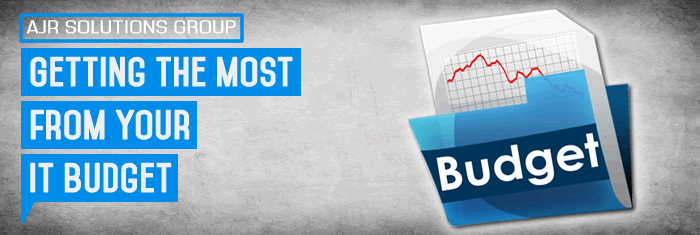In this article AJR Discuss Getting the most from your IT budget
As technology becomes ever more linked to business performance and growth, it becomes increasingly part of an organisation’s strategic planning.
Now more than ever it is vital that IT professionals are able to identify ways to help their company make more informed business decisions – and the first step is having a clear view of their current IT infrastructure and how it is performing. This information can not only help justify future spending on technology, it can also highlight areas where important savings could be made.
Here are six tips on how IT professionals can maximise their budgets to achieve better business value and intelligence:
Focus budget on must-haves not nice-to-haves
Spending money on IT that won’t add value to the business is unnecessarily wasteful. To stop this happening, the IT administrator needs to have a clear picture of what is going on in the business.
They need to communicate with senior management to better understand the long term plans that are going to affect the IT strategy. Armed with this knowledge they will be able to advise on and recommend technology that will support real business needs – avoiding investment in IT that is simply nice to have.
Make the best of the hardware you have
The temptation to spend on the latest hardware can be damaging to a company’s balance sheet. The growth of BYOD and workplace mobility has led to a massive increase in spending on tablets and smartphones as employees demand the latest technology updates. Keeping up with their demands can be a significant, and inessential, cost however.
Workstations and peripherals can add to this cost and should be replaced with discretion. Instead of replacing older models or malfunctioning equipment, there are often economies that IT administrators can make with the resources they already have. The use of network monitoring tools can identify what devices are actually useful and which can be sold off or repurposed.
Keep suppliers in check
Making sure you’ve got what you paid for is often easier said than done, but there are tools that can help an organisation find out. Monitoring data such as bandwidth speeds, data transfer history, equipment and SaaS uptime can be a good way of ensuring guarantees and service level agreements (SLAs) are being met. If they are not, an IT administrator can use this information to negotiate a discount and so reduce budget expenditure.
Maximise bandwidth
There’s no need to increase spending on larger bandwidth plans if the company isn’t making the most out of the current bandwidth. Flow monitoring will help identify peak usage and show inconsistencies and possible misuse, highlighting areas where a change in behaviour could lead to reduced usage and therefore spend.
Make a case for the big purchases
Even considering the range of new IT products and services being take up by businesses, an IT purchaser can’t expect to have everything on their wish list waved through without some evidence that it is needed. This is where network monitoring is particularly useful – identifying an underperformance in the storage capacity, for instance, with plenty of data to back up the case, makes a good argument for more investment in storage.
Scaling up to a virtual environment
Virtualisation technology is set to be adopted ever more fully by the business world, but it remains an expensive initial investment and one that can be difficult to justify to the executive team. Before jumping on the cloud bandwagon or adopting a virtual machine, organisations should evaluate current data to show the number of active applications and servers.



